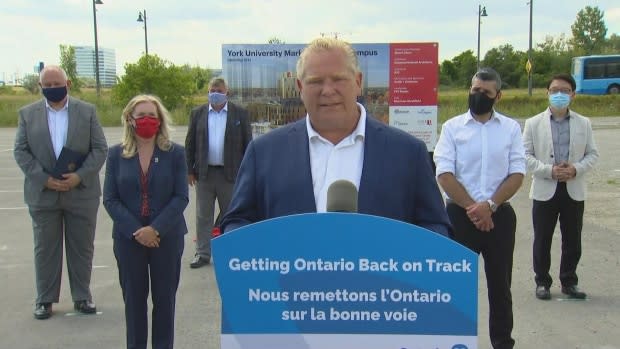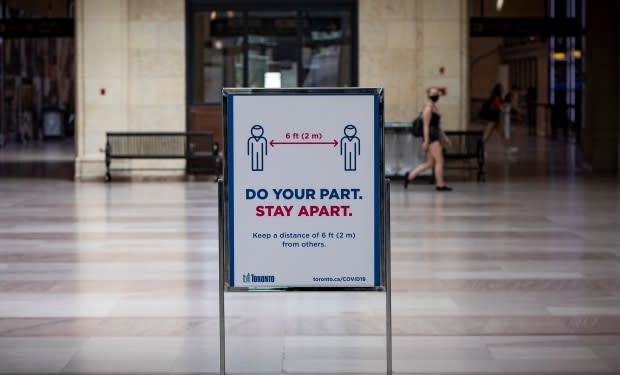Ontario reports 138 new COVID-19 cases after labs complete nearly 30,000 tests
Ontario reported 138 new COVID-19 cases on Saturday after its network of labs completed nearly 30,000 tests on Friday, a number that the health minister calls a "milestone."
Health Minister Christine Elliott said in a series of tweets on Saturday that the numbers of people hospitalized, admitted to intensive care units and intubated have all decreased.
For a second day in a row, 66 per cent of the new cases reported on Saturday are under the age of 40.
Twenty-seven out of 34 public health units in Ontario are reporting five or fewer cases. A full 16 are reporting no cases at all, Elliott said.
Ottawa is reporting 28 new cases on Saturday, while Windsor-Essex is reporting 33, Toronto is reporting 23, while Peel Region is reporting 12.
Elliott said the province has processed more than two million tests since the pandemic began in late January.
"Testing will remain a critical part of our plan to defeat this virus," she said.
Elliot said the daily new case numbers represent a 0.4 per cent increase.
On its website, the Ontario government reported on Saturday that it has a cumulative total of 38,543 cases, with 34,240 of those cases now marked as resolved.
Officially, a total of 2,759 people have died of COVID-19 in Ontario. Currently, 97 people are hospitalized, 30 are in intensive care units, with 21 of that number on ventilators.
More women than men have died of COVID-19 in Ontario
Of the official death toll of 2,759, the number of males who have died is 1,255, while the number of females is 1,464. The sex of 40 people who have died is unknown, according to Alexandra Hilkene, spokesperson for Elliott.
A CBC News count based on data provided directly by public health units, which avoids lag times in the provincial reporting system, puts the real current toll at 2,792 as of 12:30 p.m. on Saturday.
According to a daily epidemiological summary of COVID-19 in Ontario from Jan. 15 to July 24, the cumulative rate per 100,000 population is now higher in Windsor-Essex than it is in Toronto.
The Windsor-Essex public health unit has a cumulative rate per 100,000 population of 505.1, while the Toronto public health unit has a rate of 449.9.
Advocacy group opposes plan to mandate tests on farms
A group representing migrant workers is criticizing a proposal to mandate COVID-19 tests on farms in southwestern Ontario.
Chris Ramsaroop, a spokesperson for Justice for Migrant Workers, says mandatory testing will lead to "criminalization and heightened surveillance" of the workers.
But Premier Doug Ford and the medical officer of health in Windsor-Essex say they are considering the measure.
Farms have been hard hit by the novel coronavirus in recent weeks.
Officials announced on Friday that Windsor-Essex now has the highest rate of COVID-19 in the province.

Announcement on Stage 3 coming next Wednesday
Toronto, Peel and Windsor-Essex continue to be in Stage 2 of the province's reopening plan, but the premier has said an update on whether or not they will be able to proceed to Stage 3 will be made next Wednesday.
Ford said on Friday that health officials have asked for more time to "analyze the numbers" in the three areas.
"And I've always said, we can't rush this," Ford told reporters. "I'm hopeful we'll have some good news to share on Wednesday."
Stage 3, among other things, means residents would be allowed to dine indoors at restaurants or drink in pubs. Gyms and movie theatres would also be allowed to reopen.
Under Stage 3, limits on gatherings would increase to a maximum of 50 people indoors and a maximum of 100 people outdoors, with physical distancing in place.
A total of 31 public health units are now in Stage 3 in Ontario.
Seven more regions, or public health units, formally entered Stage 3 on Friday, joining the 24 that moved into Stage 3 on July 17.

Stages of reopening depend on 'key public health indicators'
Hilkene, speaking for the health minister, said the province is reopening on a regional basis as progress is made against COVID-19. Regions are determined by public health unit boundaries with a couple of exceptions, she said.
"The regional approach recognizes that every region in Ontario has experienced the COVID-19 outbreak differently," Hilkene said.
"Directed by the province, in consultation with public health officials, every region will progress through each stage when it is safe to do so. The government's decision is based on trends in key public health indicators, including virus spread and containment, along with health system and incidence-tracking capacity."
Dates of when regions are allowed to move from one stage to the next vary on local needs and the ability of businesses and services to meet workplace safety and public health guidelines, she added.
Hilkene declined to say which public health unit is now considered the province's COVID-19 hot spot. Naming a particular area could have unintended consequences and a negative impact on local businesses for a long time.
"For example, it could stigmatize communities who are already disadvantaged," she said.
Ontario's state of emergency, meanwhile, ended on Friday after 130 days.


